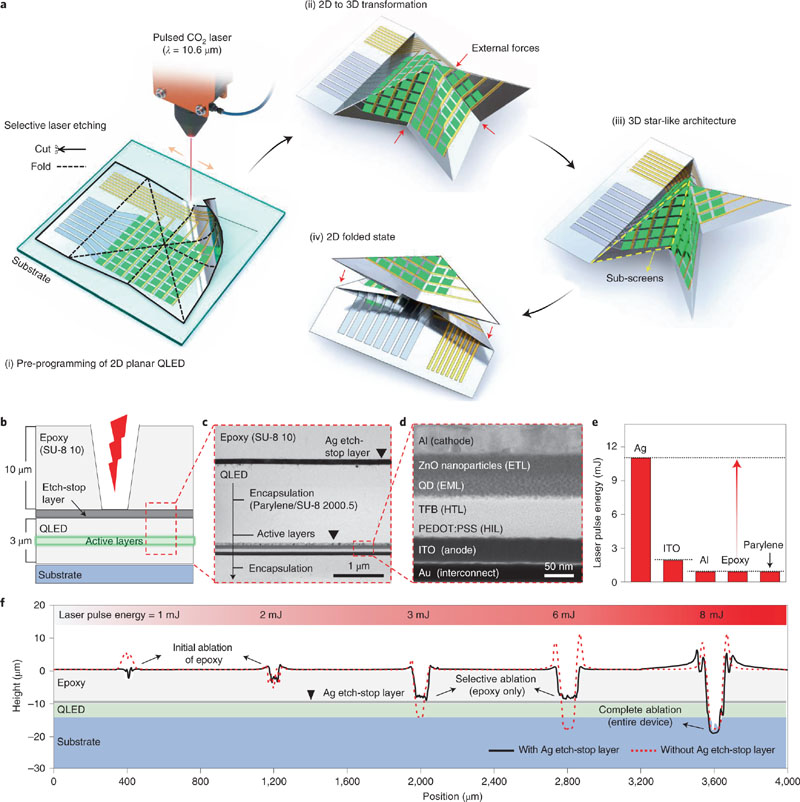NEWS
NEWS
The latest ultrathin QLED can be folded like orgami paper into complex structures
16-10-2021
QLED (Quantum dot light-emitting diode)is a latest type of lighting-emitting material featuring in outstanding electroluminescence properties ,which adopts technology of quantum dots.This latest technology does not need any bulky backlight units, so QLED display can be potentially be made into ultrathin form factor.
Recently, a latest three-dimensional foldable QLEDs has been launched, it can be freely changed into various user-customized 3D structures, such as butterflies,airplanes and pyramids.It is expected that this newest technology can provide more opportunities for next-generation electronics with custom-made form factors with complex structures and achieving dynamic three-dimensional display of visual information.
By a new production process, foldability can be added to conventional planar QLED ,epoxy film can be partially etched safely on the QLED surface.The laser-etched part is thinner that the surrounding region, so it possible to laser cut deformation lines along which QLED can be folded like origami paper.
Recently, the team further advanced this technology and developed a foldable variant of the ultrathin QLED, inspired by the ancient art of paper folding known as origami. The researchers reported three-dimensional foldable QLEDs, which can be freely transformed into various user-customized 3D structures, such as butterflies, airplanes, and pyramids. Considering the rising popularity of foldable smartphones, the advancement of foldable display technology is gaining greater importance. It is expected this technology can provide unprecedented opportunities for next-generation electronics with user-customized form factors with complex structures, as well as allowing for dynamic three-dimensional display of visual information.
The researchers endowed foldability to the conventional planar QLED via a new fabrication process that can partially etch the epoxy film deposited on the QLED surface without damaging the underlying QLED. Using a power-controllable carbon dioxide pulsed laser and the silver-aluminum alloy-based etch-stop layers, the etching depth can be precisely controlled. As the laser-etched part of the device is relatively thinner than the surrounding region, it is possible to etch out deformation lines along which the QLED device can be folded like origami paper.
By selective laser-etching technique, scientists can precisely control the radius of curvature down to 50 micrometers. In doing so, scientists could minimize the strain loaded on light-emitting components. The entire QLED could still work very well after it was folded 500 times repeatedly.This latest technology has been used to make 3D foldable QLEDs with many complex shapes. Composing of 64 individual pixels, it is estimated that the 3D foldable QLED arrays can achieve greater complexity in near future.

Recently, a latest three-dimensional foldable QLEDs has been launched, it can be freely changed into various user-customized 3D structures, such as butterflies,airplanes and pyramids.It is expected that this newest technology can provide more opportunities for next-generation electronics with custom-made form factors with complex structures and achieving dynamic three-dimensional display of visual information.
By a new production process, foldability can be added to conventional planar QLED ,epoxy film can be partially etched safely on the QLED surface.The laser-etched part is thinner that the surrounding region, so it possible to laser cut deformation lines along which QLED can be folded like origami paper.
Recently, the team further advanced this technology and developed a foldable variant of the ultrathin QLED, inspired by the ancient art of paper folding known as origami. The researchers reported three-dimensional foldable QLEDs, which can be freely transformed into various user-customized 3D structures, such as butterflies, airplanes, and pyramids. Considering the rising popularity of foldable smartphones, the advancement of foldable display technology is gaining greater importance. It is expected this technology can provide unprecedented opportunities for next-generation electronics with user-customized form factors with complex structures, as well as allowing for dynamic three-dimensional display of visual information.
The researchers endowed foldability to the conventional planar QLED via a new fabrication process that can partially etch the epoxy film deposited on the QLED surface without damaging the underlying QLED. Using a power-controllable carbon dioxide pulsed laser and the silver-aluminum alloy-based etch-stop layers, the etching depth can be precisely controlled. As the laser-etched part of the device is relatively thinner than the surrounding region, it is possible to etch out deformation lines along which the QLED device can be folded like origami paper.
By selective laser-etching technique, scientists can precisely control the radius of curvature down to 50 micrometers. In doing so, scientists could minimize the strain loaded on light-emitting components. The entire QLED could still work very well after it was folded 500 times repeatedly.This latest technology has been used to make 3D foldable QLEDs with many complex shapes. Composing of 64 individual pixels, it is estimated that the 3D foldable QLED arrays can achieve greater complexity in near future.



